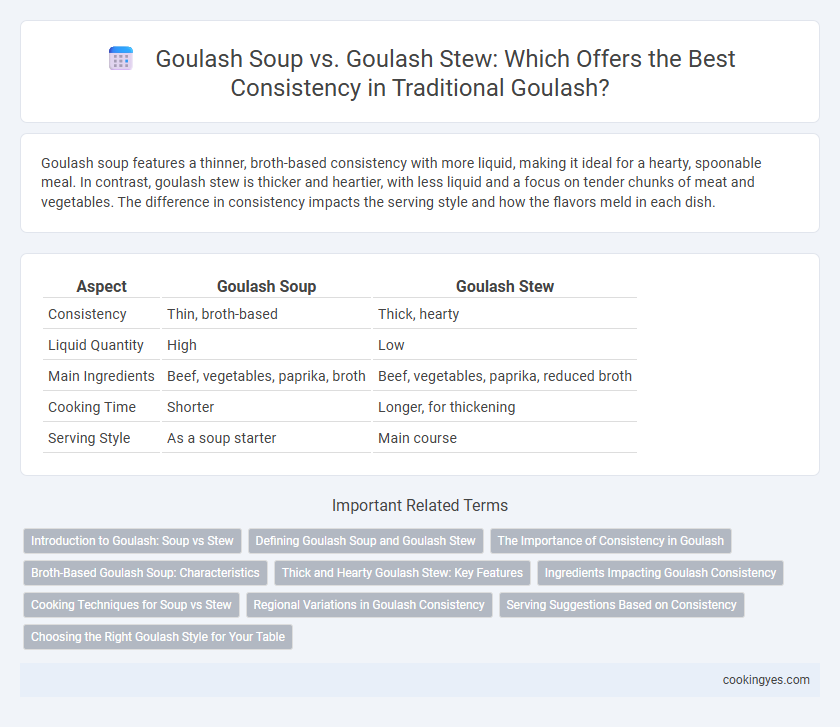Goulash soup features a thinner, broth-based consistency with more liquid, making it ideal for a hearty, spoonable meal. In contrast, goulash stew is thicker and heartier, with less liquid and a focus on tender chunks of meat and vegetables. The difference in consistency impacts the serving style and how the flavors meld in each dish.
Table of Comparison
| Aspect | Goulash Soup | Goulash Stew |
|---|---|---|
| Consistency | Thin, broth-based | Thick, hearty |
| Liquid Quantity | High | Low |
| Main Ingredients | Beef, vegetables, paprika, broth | Beef, vegetables, paprika, reduced broth |
| Cooking Time | Shorter | Longer, for thickening |
| Serving Style | As a soup starter | Main course |
Introduction to Goulash: Soup vs Stew
Goulash soup features a lighter, broth-based consistency with a rich blend of paprika, beef, and vegetables, making it perfect for a hearty starter. Goulash stew, in contrast, offers a thicker, meatier texture achieved by slow-cooking beef with onions and spices, resulting in a robust, filling meal. Hungarian cuisine highlights these variations, showcasing regional preferences and culinary techniques that define goulash's identity.
Defining Goulash Soup and Goulash Stew
Goulash soup is a traditional Hungarian dish characterized by a thinner, broth-based consistency packed with chunks of beef, vegetables, and paprika-infused spices, making it a flavorful and easy-to-sip meal. In contrast, goulash stew boasts a thicker, heartier texture with slow-cooked beef, potatoes, and rich seasoning that meld together to create a robust and satisfying dish. The key difference lies in the liquid content and cooking method, with soup offering a lighter, more liquid form and stew providing a dense, stew-like consistency.
The Importance of Consistency in Goulash
The importance of consistency in goulash lies in its impact on flavor infusion and texture, where goulash soup offers a thinner, broth-based consistency ideal for a lighter, spiced experience, while goulash stew provides a thicker, heartier texture that enhances the richness of slow-cooked meat and vegetables. Achieving the right consistency balances liquid and solid ingredients to create the desired mouthfeel and depth of flavor characteristic of traditional Hungarian cuisine. Mastering consistency ensures that each serving delivers an authentic and satisfying taste, whether enjoyed as a warm, soupy meal or a dense, stew-like dish.
Broth-Based Goulash Soup: Characteristics
Broth-based goulash soup features a clear, flavorful liquid that is rich in paprika and tender beef, creating a lighter, more soup-like consistency compared to the thicker goulash stew. This version often includes vegetables such as potatoes, carrots, and bell peppers, contributing to its hearty yet brothy texture. The broth allows the spices and beef flavors to meld seamlessly, making it a comforting, aromatic dish ideal for a warming meal.
Thick and Hearty Goulash Stew: Key Features
Goulash stew is characterized by its thick, hearty consistency achieved through slow cooking, which allows the meat and vegetables to meld into a rich, robust dish. Unlike the lighter, broth-based goulash soup, the stew incorporates less liquid and often includes ingredients like potatoes and carrots to enhance its dense texture. This makes goulash stew a satisfying meal, perfect for colder weather or when a filling, comforting dish is desired.
Ingredients Impacting Goulash Consistency
Goulash soup typically contains a higher ratio of broth to solid ingredients such as beef, potatoes, and paprika, resulting in a thinner, more liquid consistency that emphasizes rich, spiced flavors. In contrast, goulash stew features a denser mix of ingredients like chunky vegetables, tender beef, and sometimes dumplings, creating a heartier texture with less liquid to absorb seasoning and enhance thickness. The choice and proportion of ingredients like paprika, beef fat, and root vegetables directly affect the viscosity and mouthfeel, distinguishing soup from stew varieties in traditional Hungarian cuisine.
Cooking Techniques for Soup vs Stew
Goulash soup features a thinner consistency achieved by simmering meat, vegetables, and paprika in a larger quantity of broth, with longer cooking times to develop rich flavors while maintaining a lighter texture. Goulash stew uses less liquid and slower, low-heat cooking methods like braising to create a thick, hearty dish where the meat becomes tender and the sauce intensifies. The key cooking technique difference lies in the broth-to-ingredient ratio and cooking duration, which directly influence whether the final dish is a soupy or stew-like consistency.
Regional Variations in Goulash Consistency
Goulash soup, common in Hungary and surrounding Central European regions, features a thinner, broth-based consistency with a higher liquid-to-meat ratio suited for meals as a starter or light dish. In contrast, goulash stew, prevalent in Austria and parts of Germany, is thicker and heartier, with chunks of meat and vegetables simmered longer to create a rich, gravy-like sauce ideal for main courses. These regional variations stem from local culinary traditions and ingredient availability, influencing the texture and serving style of goulash across Central Europe.
Serving Suggestions Based on Consistency
Goulash soup features a thinner, broth-based consistency, making it ideal for serving with crusty bread or over egg noodles to absorb the flavorful liquid. Goulash stew is thicker and heartier, best enjoyed on its own or alongside rustic potatoes and pickled vegetables to complement its rich texture. Both variations highlight tender beef and paprika but differ in presentation to suit the desired meal experience.
Choosing the Right Goulash Style for Your Table
Goulash soup features a thinner broth with a balance of paprika, beef, and vegetables, ideal for a lighter, spoonable meal. Goulash stew offers a thicker, heartier consistency with slow-cooked meat and rich spices, perfect for a filling main course. Selecting between soup and stew depends on your desired meal density and flavor intensity, with each style highlighting classic Hungarian paprika and tender beef differently.
Goulash soup vs goulash stew for consistency Infographic

 cookingyes.com
cookingyes.com